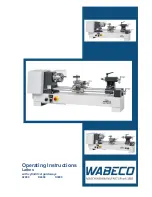
- -
Follow Rest
The traveling follow rest (F, Fig. 9) is mounted on the
saddle and follows the movement of the turning tool. Only
two fingers are required as the place of the third is taken
by the turning tool. The follow rest is used for turning
operations on long, slender workpieces. It prevents the
workpiece from the pressure of the cutting tool.
The sliding fingers are set similar to the steady rest, free
of play, but not binding. Always lubricate adequately with
lead based grease during operation.
Controls
1.
Control Panel
-
Located on top of headstock.
A.
Coolant On-Off Switch
(A, Fig.10) turns coolant
pump on and off.
B.
Power Indicator Light
(B, Fig.10) - lit whenever
Lathe has power.
C.
Emergency Stop Switch
(C, Fig.10) - depress to
stop all machine functions. (
Caution:
Lathe will still
have power). Twist to re-set.
D.
Jog Switch
(D, Fig. 10) - depress and release to
advance spindle momentarily.
2.
Headstock Gear Change Levers
(E, Fig. 10)-Located
on front of headstock at the top. Move levers left or
right to desired spindle speed.
3.
Leadscrew/Feedrod Directional Lever
(F, Fig. 10)-
Located on front of headstock. Moving the lever up
causes carriage travel toward the tailstock. Moving the
lever down causes carriage travel toward the
headstock. Do not move lever while machine is
running.
4.
Feed/Lead Selector Lever
(G, Fig. 10) - located on
the front of the headstock at the top. Used whenever
setting up for threading or feeding.
Caution:
in the
“A”
position, never run the lathe higher than 770 RPM.
5.
Feed/Lead Selector Lever
(H, Fig. 10) - located on
the front lower right corner of the headstock. Used in
setting up for feeding and threading. Positions "F
” and
Fig. 10
11
F
G
E
B
A D H C






























